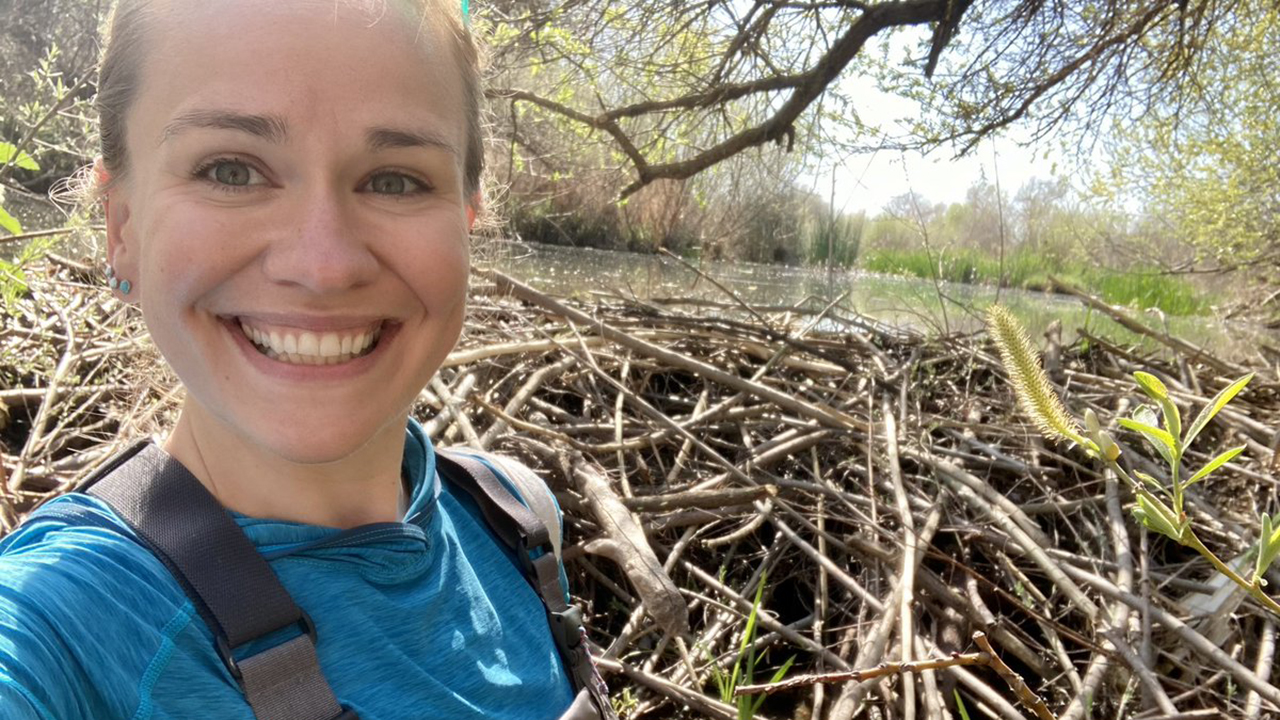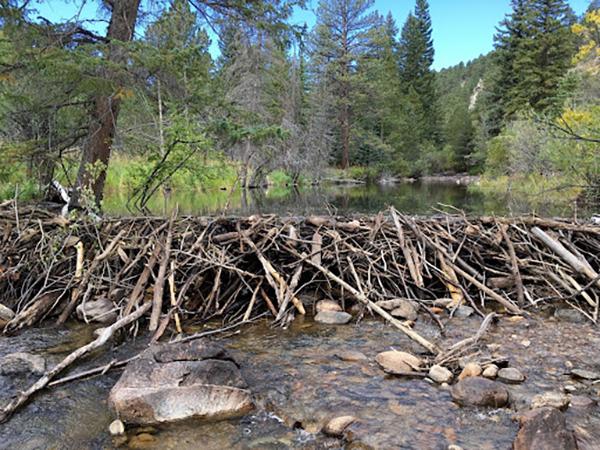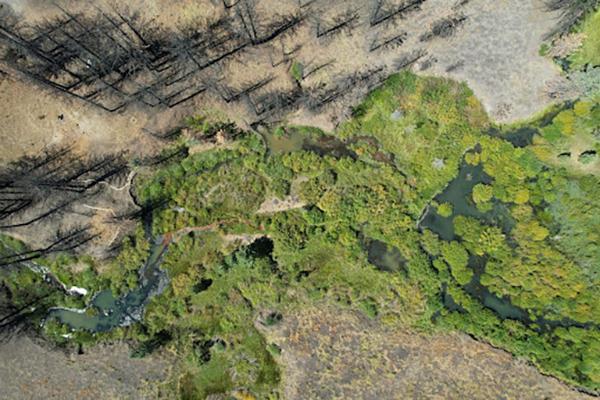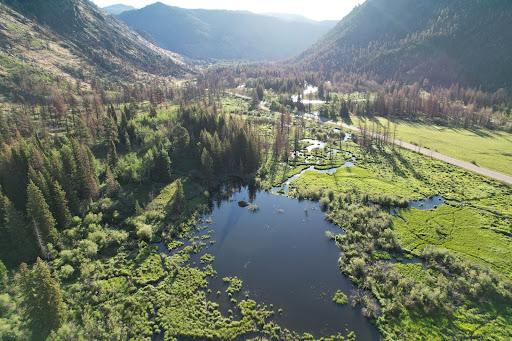
Emily Fairfax in front of beaver dam.
Photo credit: Emily Fairfax
An assistant professor of geography in the College of Liberal Arts and an affiliate with the Saint Anthony Falls Laboratory in the College of Science and Engineering, Emily Fairfax is an ecohydrologist, which means she studies how plants and animals affect water and vice versa. “Beavers are the main focus of my research,” she said. “They have such an outsized influence on the waterways they inhabit. I don't think I'll ever run out of research questions with them.”
Despite a lifelong interest in science, Fairfax initially worked as a systems engineer at Los Alamos National Laboratory, a role that left her wanting. “I was moping on the couch one afternoon when a PBS documentary called Leave it to Beavers came on. They interviewed all these scientists who pointed out we still don’t know everything about beavers despite the valuable ecosystem service they provide. I was totally hooked.”
Fairfax made a career pivot, earning a PhD in geology with a certificate in hydrologic sciences from the University of Colorado Boulder. She then taught at California State University Channel Islands before taking on her current position at the University of Minnesota in 2023.
Using Modern Technology to Better Illustrate Beaver Impact
Fairfax uses remote sensing, modeling, and field work to understand how beaver ecosystem engineering can create drought and fire-resistant patches in the landscape under a changing climate. For example, Fairfax will consider wildfire impact by looking at river corridors to see which parts were protected and which parts were burnt. She will then try to understand how or why fire protection had occurred and usually determine beaver involvement, which is what she did when studying the impacts of three megafires that hit Colorado in 2020.
“Using remote sensing through satellites, I was able to look at fire scars at a high level and see strings of unburnt vegetation along many of the rivers. Through more remote sensing, this time high resolution imagery, I went through each fire scar and mapped out every beaver dam, about 2000 in total, and could see if the unburnt regions correlated with the presence of beaver dams,” explained Fairfax. “I use models like the Beaver Restoration Assessment Tool (BRAT) to identify physically and ecologically similar places within the river corridor that do and do not have beaver within them so that I can better isolate the influence of beavers versus other hydrologic or geomorphic drivers of fire resistance.”

Photo credit: Emily Fairfax
Finally, Fairfax visits the field to verify remote sensing data, using optical and multispectral drones to capture high resolution data and making note of all the things she can’t see with satellites or models, such as ongoing presence of beavers (or not), if there are fish in the ponds, if the bird population is healthy, and the sharpness of the gradient between burnt and unburnt areas.
“Putting it all together, I can clearly and confidently say that not only do beavers create fire-resistant wetlands but also show evidence that those wetlands are valuable for people, plants, and animals struggling.”
Collaboration with Google
This type of work captured the attention of then-Google employees Dan Ackerstein and Eddie Corwin who, as part of Google’s “AI for Social Good” initiative, wanted to use AI to find beaver dams in support of beaver conservation and restoration. While they had enthusiasm for the idea, they needed to know if it was actually possible. Fairfax told them it was probably possible, but they would need a lot of training data since beaver dams are so varied and irregular. Fairfax wanted the model to be developed because it would make her research workflow more efficient, and Ackerstein and Corwin wanted the model developed so they could leverage Google’s technical expertise for environmental good.

Photo credit: Emily Fairfax
Earth Engine Automated Geospatial Elements Recognition (EEAGER) was born. As there is currently no data-based estimate of beaver population numbers and no large-scale information about population changes, EEAGER is working to establish a baseline of beaver habitats and influence in North America to better identify large-scale shifts in beaver population dynamics and assess beaver management. As EEAGER’s beaver scientist, Fairfax provides insight into how and why beavers build the way they do and describes how that looks in remotely sensed imagery, which is then used to improve the model’s performance. Fairfax’s lab has also supplied over 20,000 training data points from their hand mapping work.
“Beavers are increasingly being looked at as a partner and nature-based solution for climate change. As governmental entities and private interests take actions that affect beavers, we need a better way to monitor the watershed-scale (and larger scale) impacts of those actions. EEAGER lets us track the presence and absence of beavers faster and cheaper than we ever could before.”
For other researchers interested in partnership with Google, Fairfax said, “Getting connected is sometimes just luck (like what happened with me), but Google also runs booths at a lot of the big STEM conferences. The folks working those booths are great to chat with, and they can help connect you to the right people within the organization to answer your questions or start discussing collaborations.”
Fairfax is also actively involved in research to better characterize the historic range of and landscape alterations by beavers at different periods over the last 10,000 years using ancient sedimentary DNA and leading research on how to work with beavers most effectively. She studies beaver relocation practices and outcomes and even helped relocate beavers in California in 2023, the first relocation in the state in 70 years and first ever done with tribal partners on tribal land.

Photo credit: Emily Fairfax
Why should we care about beavers?
“Beavers are intelligent, gentle animals that do an enormous amount of work to improve biodiversity, protect sensitive species during droughts, floods, and fires, and keep our riverscapes healthy. A single family of beavers can tend to and engineer 2 kilometers of stream. They work hard, they work fast, and they work for free. All we have to do is let them.”
Wetlands are a necessary part of a healthy watershed, beavers make wetlands, and there aren't enough beavers. Currently the beaver population in the US is about 10% of what it was before the fur trade. While Fairfax doesn’t expect to get back to the historic population numbers due to how much land use has changed, 10% is still too low.
Human-wildlife conflict is one of the reasons beaver populations are still relatively low. The same ecosystem engineering behaviors that make beavers powerful wetland creators – chewing trees, creating ponds, NS damming streams – can also make them difficult neighbors when it's a favorite tree getting chewed or a driveway being flooded. In those situations, landowners frequently choose to kill the beavers to remove the conflict, and new beavers will show up and move in as long as that habitat is available. Fortunately, non-lethal beaver management technologies have significantly improved in recent decades and compromising with beavers is easier than ever. For example, pond-levelers can be installed to reduce flooding and trees can be painted with a sand/paint mixture or protected with fencing.
“Across the continent a lot of governments, non-profits, and private entities have started investing in beaver conservation as a nature-based solution for preserving freshwater resources and ecosystems. It's still early, but I hope that those efforts lead to healthier beaver populations and riverscapes across the continent. With climate change showing no real signs of stopping or slowing, we need all the help we can get when it comes to protecting plants, animals, and water–even if that help is a giant paddle-tailed rodent.”